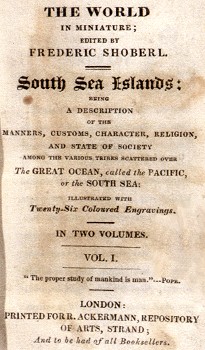 |
surfresearch.com.au
shoberl : south sea islands, 1824 |
| home | catalogue | history | references | appendix |
|
Two volumes of his extensive The World in Miniature series, Shoberl has edited from a number Pacific accounts that were avialable to him, probably starting with John Hawkesworth's Voyages in the Southern Hemisphere,1773, that contained edited selections from Byron, Carteret, Wallis and Cook's first voyage.
Interestingly, he
does not report surfriding in Hawaii, only paddling on boards "shaped
like an anchor stock" (this is no doubt derived from Archibald Campbell),
while Banks' surfriding account from Tahiti is related (in the voice of
Cook) in Volume Two.
See:
1812 Archibald
Campbell : Surfboard Paddling,
1812.
and
1769 Joseph Banks
: Surfriding in Tahiti.
The Friendly Islands
Page 177
A singular kind
of sport practised by these people consists of carrying a large stone under
water ten feet deep from one point to another, at the distance of seventy
yards.
The difficulty
is to persue a straight course; a person may thus run along the bottom
twice as fast as another can swim.
The Sandwich Islands
Page 223
From their earliest
years the islanders spend much of their spare time in the water, and constant
practice renders them so dexterous that they seem quite as much as as ease
in that element as on land.
They frequently
swim several miles off to ships, sometimes resting upon a plank shaped
...
Page 234
... like an anchor stock, and paddling with their hands, but more commonly without any assistance whatsever.
The Marquesas
Page 318
The dexterity
of these people in swimming also excites astonishment
They appear to
be a sort of amphibious animals, capable of living just as well in the
water as on land.
They will throw
themselves from high steep rocks into the sea; remain for a considerable
time in the same place as if they were standing upright, with head and
shoulders above the water; and ...
Page 319
... bring a number
of things for barter, which they hold above the surface to keep from getting
wet.
Some of them,
says Langdorff, would swim about the ship the greatest part of the day
without appearing tired.
Mafu, who has
already been mentioned, though he had never been on board a European ship,
would of his own accord run up the main-mast several times successfully
and throw himself into the sea, to the great astonishmnet of the spectators.
It was impossible
to see without horror and amaze, how he would spring from such a height
and balance himself in the air for some seconds with his legs drawn up
and his ...
Page 320
... head errect.
Such was the
force of the fall and weight of his body, that several seconds elapsed
before he again rose to the surface.
Volume Two
Tahiti
Page 56
Both men and women
are remarkably cleanly, and constantly wash the whole body three times
a day in running water.
Accustomed to
that element from their infancy, they are most expert swimmers.
Captain Cook
saw ten or twelve of them swimming for amusement on a part of the shore
where a tremendously high surf broke, insomuch that no European boat could
have lived in it, and the best European swimmer must have perished, as
the shore was covered with pebbles and ...
Page 57
... large stones.
Whenever a surf
broke over them, they dived under it and rose again on the other side.
The stem of an
old canoe added much to their sport.
This they took
out before them and swam with it as far as the outermost breach: when two
or three getting into it and turning the square end to the breaking wave,
were driven in towards the shore with incredible rapidity. sometimes almost
to the beach; but generally the wave broke over them before they got half
way: in which case they dived and rose to the other eide with the canoe
in their hands, and swimming out with it again were again driven back.
This amazing
expertnes drew the attention of the ...
Page 58
... Captain for more than half all hour, during which time none of the swimmers attempted to return to the shore, but seemed to enjoy the diversion in the highest degree.
We are assured that the women excel in this sport, and that if a shark should make its appearance among the playful swimmers, they all surround and force him on shore, if they can once get him into the surf, though they use no instruments for the purpose; and should he escape, they still continue their frolics without any apprehension of danger.
On one occasion a bead dropped from Captain Cook's ship, and intended for is child six years of age in a canoe, ac- ...
Page 59
... cidentlly
missed the boat and fell into the sea.
The boy immediately
leaped overboard, dived after and recovered it.
As a reward for
this feat some more beads were dropped to him; which excited a number of
men and women to amuse the officers with their amazing feats of agility
in the water; and they not only fetchted up several beads scattered at
once, but likewise large nails which, from their weight, descended quickly
to a considerable depth.
Some of them
continued a long time under water, and the velocity with which from its
clearness they were seen to go down was very surprizing.
 |
The World in Miniature - South Sea Islands. Being a Description of the Manners, Customs, Characters, Religion, and State of Society amoung the Various Tribes scattered over the Great Ocean, called the Pacific or the South Sea. In Two Volumes. Illustrated with Twenty-Six Coloured Engravings. Printed for B. Ackermann, Repository of Arts, Strand, London, 1824. |

| home | catalogue | history | references | appendix |